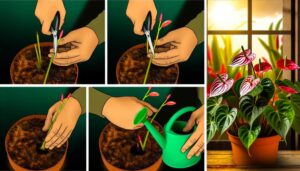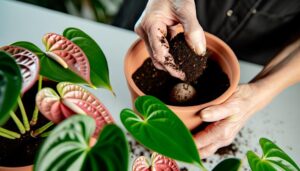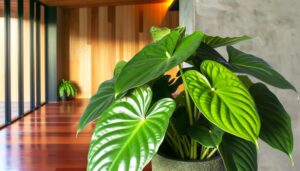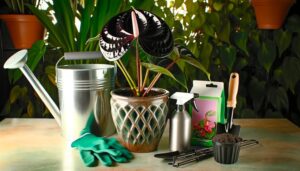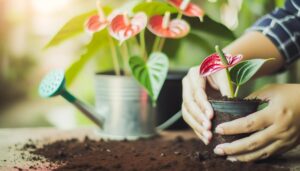Anthurium in Water Vs. Soil: Key Differences
Growing anthuriums in water versus soil involves several key differences. Soil offers essential nutrients and better root aeration, fostering thicker and more robust roots.
In water, you have precise nutrient control but contend with fluctuating oxygen levels that may impact root health. While soil-grown anthuriums are prone to a variety of pests, water setups primarily face algae and root rot issues.
Hydroponic systems can be cost-effective but require frequent water changes and monitoring. Soil-based cultivation needs higher initial investment but provides a buffered nutrient environment.
Understanding these variations will help you enhance your anthurium care for peak health.
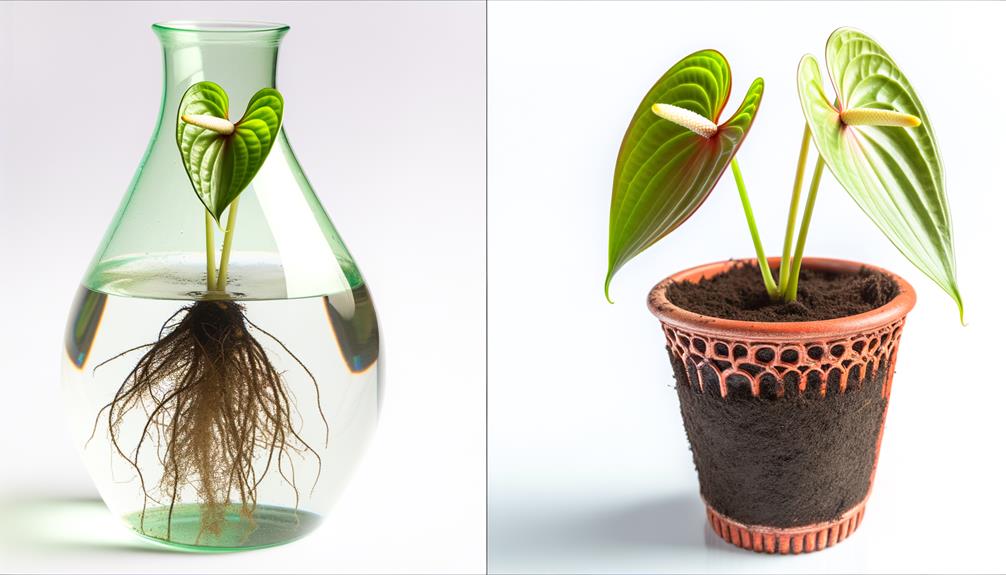
Key Takeaways
- Nutrient Supply: Soil provides a stable nutrient buffer, whereas hydroponics require precise nutrient monitoring and regular hydroponic fertilizers.
- Root Health: Soil fosters thicker, robust roots, while water cultivation leads to fibrous roots that need careful oxygen management.
- Watering Needs: Soil-grown Anthuriums need watering when the top inch is dry; hydroponic Anthuriums need weekly water top-ups.
- Pest Management: Soil-grown plants are prone to pests like fungus gnats, unlike water-grown plants which mainly face root rot and algae issues.
- Cost and Maintenance: Hydroponic setups have lower initial costs but require frequent monitoring; soil setups need quality potting materials and less frequent adjustments.
Growth Rate
The growth rate of Anthurium plants varies considerably between water and soil cultivation methods due to differences in nutrient availability and root oxygenation.
In soil, Anthuriums benefit from a complex ecosystem that provides essential macro and micronutrients. The soil's structure also facilitates ideal root aeration, promoting robust growth.
Conversely, water cultivation offers a more controlled environment, allowing precise nutrient adjustments. However, water lacks the natural buffering capacity of soil, making nutrient imbalances more likely. Additionally, oxygen levels in water can fluctuate, potentially stunting root respiration and overall plant vigor.
Root Health
Maintaining ideal root health in Anthuriums involves understanding the distinct effects of water and soil environments on root structure and function. In water, roots develop a more fibrous structure, enhancing oxygen absorption but making them prone to rot if not managed properly. You'll often notice roots becoming translucent and fragile, signaling the need for frequent water changes to prevent bacterial growth.
Conversely, soil environments promote thicker, more robust roots, enhancing structural support and resilience. However, soil can compact around roots, leading to poor aeration and potential root suffocation. Ensuring well-draining soil mixtures with proper aeration is essential.
Regularly inspect roots for health indicators like firmness and color, adjusting environmental conditions to maintain optimal root strength.
Nutrient Absorption
When it comes to nutrient absorption, Anthuriums in water need regular supplementation with hydroponic fertilizers to guarantee they receive essential minerals, contrasting with soil-grown counterparts that benefit from slow-release nutrients within the substrate. In water, you'll need to carefully monitor and adjust nutrient levels to prevent deficiencies. Soil, however, offers a buffered environment where nutrients are gradually released, providing a more stable nutrient supply.
| Aspect | Anthuriums in Water | Anthuriums in Soil |
|---|---|---|
| Nutrient Source | Hydroponic Fertilizers | Substrate Nutrients |
| Stability | Requires Monitoring | Naturally Buffered |
| Application | Frequent Supplementation | Infrequent Top-Dressing |
| Risk of Deficiency | High | Low |
Understanding these differences helps you optimize your plant care strategy for thriving Anthuriums.
Watering Frequency
Balancing nutrient absorption intricacies, you must also adjust watering frequency differently for Anthuriums in water compared to those in soil.
In hydroponic setups, water levels should be topped up regularly, typically once a week, to guarantee roots remain submerged and hydrated. Conversely, soil-grown Anthuriums require a more nuanced approach. You should water them when the top inch of soil feels dry, usually every 7-10 days, depending on environmental conditions.
Overwatering leads to root rot, while underwatering can cause dehydration stress. Monitoring soil moisture with a meter provides precision. Each method demands careful observation and adjustment, ensuring peak hydration without compromising plant health.
Adapt your watering routine based on seasonal changes and plant growth stages for best results.
Pest Management
Effective pest management for Anthuriums necessitates proactive monitoring and targeted interventions to mitigate infestations. In water-grown Anthuriums, you're less likely to encounter soil-borne pests like fungus gnats, but you might still face issues with root rot or algae. Conversely, soil-grown Anthuriums are vulnerable to a broader range of pests, including aphids, mealybugs, and spider mites. Regular inspection and immediate action are essential for both mediums.
| Pest Type | Preferred Medium |
|---|---|
| Fungus Gnats | Soil |
| Root Rot | Water |
| Aphids | Soil |
| Algae | Water |
| Spider Mites | Soil |
Maintenance Effort
In analyzing maintenance effort, you'll notice that watering frequency needs and root health management notably differ between water and soil cultivation.
Anthuriums in water require frequent monitoring to prevent stagnation and nutrient deficiencies, whereas soil-grown anthuriums need regular but less frequent watering schedules.
Additionally, root health in water can be more challenging to maintain due to the risk of rot, while soil provides a more stable environment for root development.
Watering Frequency Needs
When cultivating Anthurium, the watering frequency varies greatly between hydroponic setups and traditional soil-based methods, impacting the overall maintenance effort required.
In hydroponic systems, Anthurium thrives with a consistent water level, necessitating weekly water changes to prevent stagnation and nutrient depletion.
Conversely, soil-grown Anthurium demands a more nuanced approach. Typically, you should water when the top inch of soil feels dry, approximately every 7-10 days, depending on ambient humidity and temperature. Overwatering can lead to root rot, so precise moisture monitoring is critical.
While hydroponic setups require regular, predictable maintenance, soil-based cultivation demands more frequent, careful observation. Each method's watering frequency directly influences the time and effort you'll invest in maintaining ideal plant health.
Root Health Management
Maintaining root health in Anthurium requires distinct strategies depending on whether the plant is grown hydroponically or in soil, impacting the overall maintenance effort.
In hydroponic systems, you'll need to maintain water quality rigorously, preventing root rot by ensuring adequate oxygenation and using nutrient solutions judiciously. Regularly clean containers to avoid biofilm buildup, which can suffocate roots.
Conversely, soil-grown Anthuriums demand well-aerated, well-draining substrates. You'll need to monitor for signs of compaction and periodically repot to refresh nutrient levels and aeration. Fungus gnats and root-bound conditions are more common issues in soil, requiring vigilant pest management and root pruning.
Each method has unique challenges that necessitate consistent, knowledgeable interventions to maintain best root health.
Aesthetic Appeal
The visual allure of anthuriums can vary greatly depending on whether they're cultivated in water or soil. When grown in water, the transparent medium showcases the intricate root structures, creating a minimalist, modern aesthetic. Conversely, soil-grown anthuriums exhibit a more traditional, lush appearance with robust foliage.
| Aspect | Water Cultivation | Soil Cultivation |
|---|---|---|
| Root Visibility | Highly visible, intricate roots | Hidden, less focus on roots |
| Overall Aesthetic | Minimalist, contemporary | Traditional, lush |
| Maintenance Display | Clean, elegant water vessels | Natural, earthy potting containers |
Each method offers distinct visual benefits. Water cultivation emphasizes clarity and simplicity, making it ideal for modern interiors. Soil cultivation, however, enhances the plant's natural, verdant beauty, perfect for creating a vibrant, earthy atmosphere. Choose based on your aesthetic preference and desired ambiance.
Adaptability
Anthuriums' adaptability to different growing materials underscores their resilience and versatility, making them suitable for both novice and experienced gardeners. These plants thrive in soil due to its nutrient availability and moisture retention.
When cultivated hydroponically, anthuriums exhibit remarkable tolerance to water-based environments, leveraging their epiphytic nature. You'll find that soil-grown anthuriums demand well-aerated substrates to avoid root rot, requiring a mix of peat, perlite, and orchid bark.
Conversely, water-grown anthuriums require regular water changes to prevent stagnation and maintain oxygen levels. Both methods require specific care routines but offer flexibility in cultivation practices.
Ultimately, understanding anthuriums' adaptability enables you to select the best growing material based on your maintenance capabilities and aesthetic preferences, maximizing plant health and growth.
Cost Implications
When evaluating cost implications, you'll need to take into account both initial setup expenses and long-term maintenance costs.
Hydroponic systems for anthuriums may involve higher upfront costs due to specialized materials, while soil-based setups generally require less initial investment.
However, ongoing maintenance costs can balance out these differences, as water-based systems often demand more frequent monitoring and adjustments compared to soil.
Initial Setup Expenses
Setting up anthuriums in water generally incurs lower initial expenses compared to cultivating them in soil, due to the reduced need for traditional potting supplies. With water-based setups, you'll primarily invest in a suitable container and perhaps some decorative stones or marbles for root support.
Conversely, soil cultivation requires purchasing quality potting soil, fertilizers, and appropriately sized pots. Additionally, soil-grown anthuriums might necessitate drainage layers and possibly a potting mix tailored for best aeration. This not only increases the initial outlay but also demands more precise resource allocation.
Hence, if budget constraints are a concern, starting with hydroponic methods for anthuriums can be a cost-effective and straightforward choice, minimizing the financial burden of traditional gardening supplies.
Long-term Maintenance Costs
Long-term maintenance costs for anthuriums depend heavily on the chosen growing medium, with water-based systems typically incurring lower ongoing expenses compared to soil cultivation. In hydroculture, you'll save on fertilizers, pesticides, and soil amendments, which are essential for soil-grown plants. Additionally, water-based setups simplify pest control, further reducing costs.
| Cost Factor | Water-Based Systems | Soil Cultivation |
|---|---|---|
| Fertilizers | Lower | Higher |
| Pesticides | Minimal | Regular |
| Soil Amendments | Not required | Frequent |
| Pest Control | Simplified | Complex |
| Overall Expenses | Reduced | Elevated |
Ultimately, choosing a water-based system can streamline your maintenance routine, offering a cost-effective and efficient approach to anthurium care.
Environmental Impact
Analyzing the environmental impact of growing Anthurium in water versus soil reveals distinct differences in resource consumption and ecological footprint. Hydroponic cultivation demands continuous water circulation, potentially leading to higher water usage if not managed efficiently. However, it eliminates the need for chemical fertilizers and pesticides, reducing soil degradation and groundwater contamination.
Conversely, soil-based cultivation can contribute to soil erosion and requires regular fertilizer applications, impacting soil health and increasing the risk of runoff pollution. Additionally, soil-grown plants often need more frequent repotting, generating more waste.
Conclusion
In comparing anthuriums in water versus soil, you've uncovered nuances in growth rate, root health, and nutrient absorption. Soil-grown anthuriums demand less frequent watering and offer superior pest management, while water cultivation dazzles with unmatched aesthetic appeal. Adaptability and cost considerations vary, yet the environmental impact can't be overstated.
Ultimately, your choice hinges on balancing these factors, but remember—cultivating anthuriums in water is like harnessing botanical wizardry, crafting a living masterpiece with roots that thrive in the aquatic domain.

